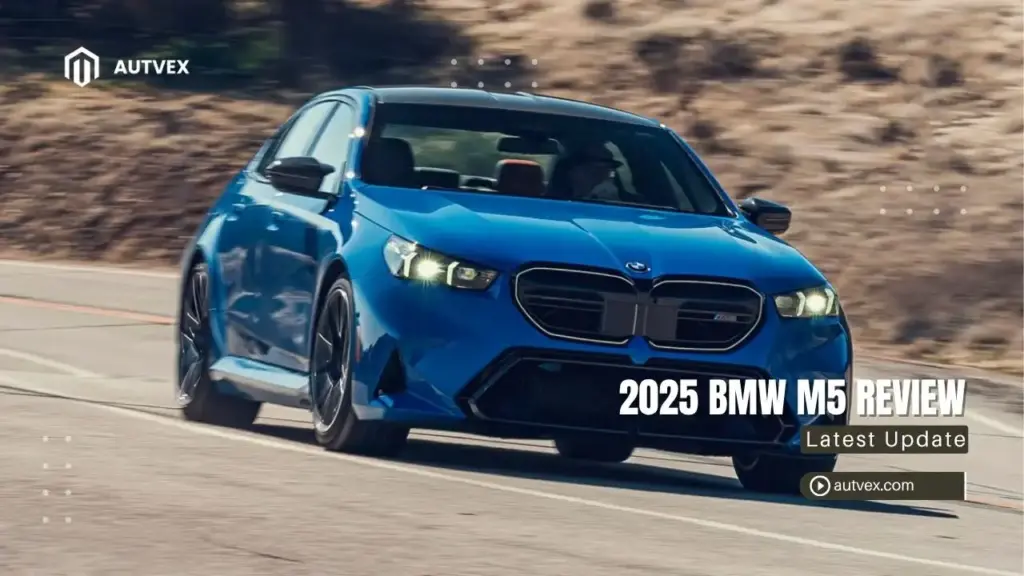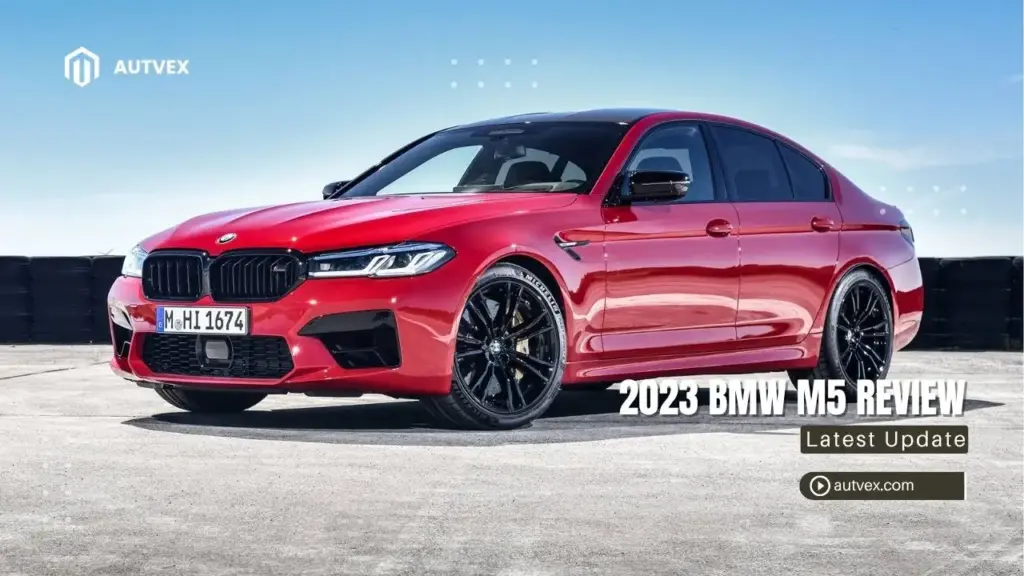You may also like:
The 2025 BMW M5 marks a revolutionary transformation for the iconic super sedan, becoming BMW’s first-ever plug-in hybrid M5 in the model’s 40-year history[1]. Combining a twin-turbocharged 4.4-liter V8 engine with an electric motor, this seventh-generation (G90) M5 delivers a combined 717 horsepower and 738 lb-ft of torque while offering 25-27 miles of EPA-estimated all-electric range[1][2]. Starting at $119,500-$123,275, the M5 accelerates from 0-60 mph in just 3.0-3.4 seconds—rivaling dedicated supercars—but its significant 5,251-pound curb weight (1,000+ pounds heavier than the previous F90 generation) fundamentally alters the driving experience that defined earlier M5 models[1][3].
This comprehensive review examines whether BMW’s hybrid gamble preserves the M5’s legendary performance-sedan character or sacrifices driving purity for technological advancement and efficiency gains.
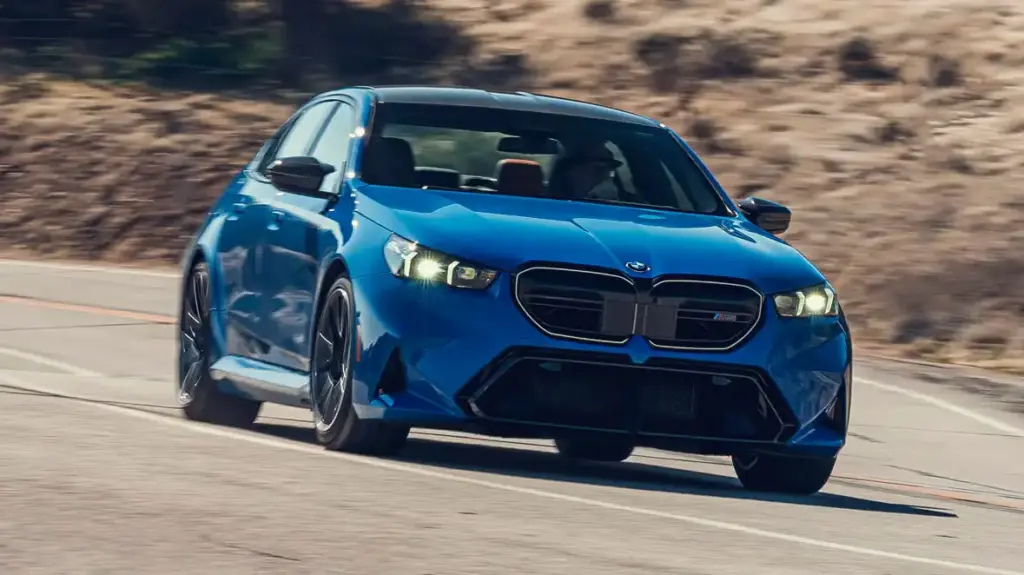
2025 BMW M5 Overview: What’s New & Key Changes
First-Ever Plug-In Hybrid M5
The G90-generation M5 represents a seismic shift from BMW’s pure-combustion heritage[1]. For the first time in M5 history, buyers can drive emissions-free in urban environments while retaining access to 577 horsepower from the S68 twin-turbo V8 when performance demands arise. Available as both a traditional sedan and the first-ever M5 Touring wagon offered in the United States, the 2025 M5 positions itself as a technological showcase for BMW M Division’s electrified future[2].
| M5 Generation | Years | Engine | Power | Weight |
|---|---|---|---|---|
| E28 (First) | 1985-1988 | 3.5L I6 | 256 hp | 3,570 lbs |
| F90 (Previous) | 2018-2024 | 4.4L V8 TT | 617 hp | 4,345 lbs |
| G90 (2025) | 2025-Present | 4.4L V8 TT + Electric | 717 hp | 5,251 lbs |
Price positioning ranges from $119,500 to $123,275 for base configurations, with fully-loaded examples reaching $146,225[1]. This premium pricing reflects the M5’s comprehensive standard equipment and advanced hybrid technology integration.
Hybrid Powertrain Introduction
The plug-in hybrid system combines 577 hp and 553 lb-ft from the V8 with 194 hp and 207 lb-ft from an integrated starter-generator electric motor mounted within the eight-speed automatic transmission[1][2]. The 14.8-kWh usable battery (18.6 kWh gross capacity) provides enough electric range for typical commutes, with the EPA estimating 25-27 miles of emissions-free driving[1].
Charging capability varies by body style: the sedan includes a 7.4 kW onboard charger, while the M5 Touring upgrades to 11 kW for faster replenishment times[2]. Full charging from empty requires approximately 2-3 hours on Level 2 equipment, making overnight charging practical for daily EV-mode operation.
The hybrid system’s seamless power delivery eliminates traditional turbo lag, with electric motor torque filling gaps in the V8’s powerband to create what MotorWeek describes as “EV-like immediacy”[2]. This instantaneous response transforms the M5’s acceleration character compared to previous pure-combustion models.
The Weight Trade-Off: 5,251 Pounds
The elephant in the M5’s cabin is its 1,045-pound weight gain over the F90 generation[3]. This mass increase stems from multiple sources:
- Battery pack: ~485 lbs (14.8 kWh usable capacity)
- Electric motor & power electronics: ~220 lbs
- Reinforced chassis structure: ~190 lbs to handle increased torque
- Additional sound insulation: ~75 lbs for hybrid refinement
- Wider body panels & track: ~75 lbs for enhanced stability
According to Autvex automotive experts, this weight penalty fundamentally changes the M5’s dynamic character from a nimble sports sedan to a grand touring performance machine that prioritizes straight-line acceleration over agility[3]. BMW engineers employed wider tracks, adaptive suspension tuning, and four-wheel steering to mask the mass, but physics ultimately limits how well technology can disguise 5,251 pounds through tight corners[1].
For perspective, the 2025 M5 weighs just 50 pounds less than a BMW X5 M Competition SUV, making it heavier than some mid-size luxury crossovers[4].
Target Buyer Profile & Use Cases
The 2025 M5 appeals to distinct buyer segments:
- Executive commuters seeking luxury performance with EV-mode efficiency for city driving
- Tech-forward enthusiasts prioritizing cutting-edge innovations over traditional analog feel
- Families requiring practical five-passenger super sedan capability with legitimate cargo space
- Daily drivers with occasional track aspirations rather than dedicated weekend warriors
Buyers considering how long it takes to buy a car should expect 2-4 hours at BMW dealerships for the M5 purchase process, including test drives, configuration selection, and financing arrangements.
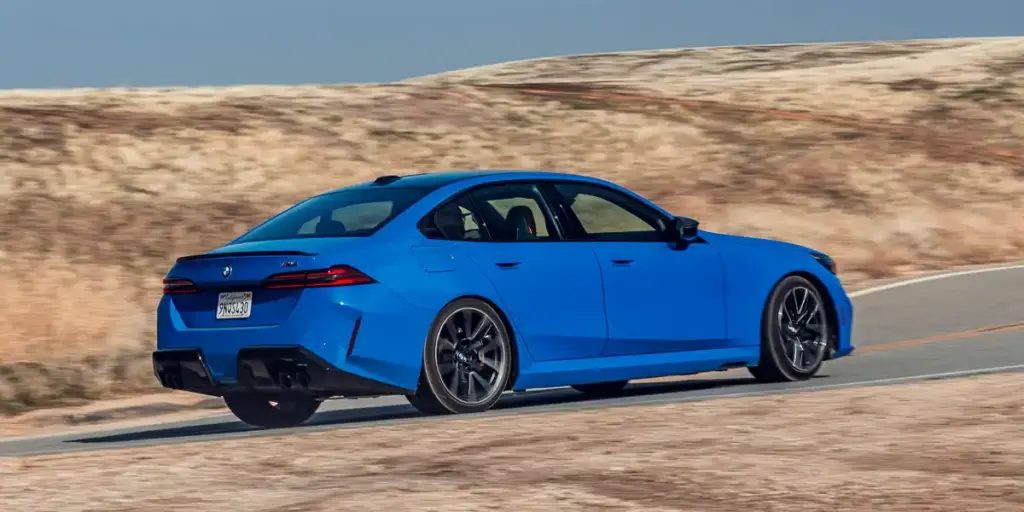
2025 BMW M5 Style & Exterior Design
Aggressive Widebody Design Language
The M5’s muscular proportions immediately distinguish it from standard 5-Series models[1]. Key styling elements include:
- Extended rear fenders: 2.8 inches wider than standard 5-Series to accommodate broader track
- M-specific kidney grille: Available with optional illuminated surround
- Staggered wheel setup: 20-inch front, 21-inch rear performance wheels
- Quad exhaust tips: Active-flap system adjusts sound character by drive mode
- Carbon-fiber components: Aerodynamic elements including front splitter and rear diffuser
The design communicates performance intent without resorting to excessive aggression, maintaining BMW’s understated German luxury aesthetic while signaling the M5’s capabilities to knowledgeable enthusiasts.
Dimensions & Physical Presence
| Dimension | Measurement | Context |
|---|---|---|
| Length | 200.6 inches | Nearly 17 feet overall |
| Width | 77.6 inches | Wider than many full-size sedans |
| Height | 59.4 inches | Low-slung sports sedan profile |
| Wheelbase | 118.3 inches | Generous rear legroom |
| Ground Clearance | ~5.1 inches | Limited for deep snow |
| Curb Weight | 5,251 lbs (sedan) | 5,550 lbs estimated (Touring) |
The 118.3-inch wheelbase contributes to exceptional rear-seat space while maintaining balanced proportions[1]. The Touring wagon variant adds practical cargo capacity (17.7 cubic feet, expanding to 57.6 cubic feet with rear seats folded) without compromising the M5’s performance credentials[1].
M-Specific Styling Elements
Distinctive M5 touches include:
- Functional brake cooling ducts integrated into front fascia
- M badging on front fenders, steering wheel, and rear decklid
- Mirror caps in body color or optional carbon fiber
- Shadow line trim with gloss black accents
- M Sport differential with active cooling vents
These elements differentiate the M5 from lesser 5-Series variants while maintaining visual cohesion with BMW’s broader M model lineup, including the 2025 BMW 2-Series entry-level performance offerings.
Design Evolution from F90 Generation
Visual comparisons to the previous F90 M5 reveal modernized styling with:
- Larger kidney grilles reflecting BMW’s current design language
- Slimmer LED headlights with sharper, more angular profiles
- Smoother surface development reducing visual complexity
- Integrated hybrid design cues including charging port placement
The hybrid system’s battery packaging required chassis modifications, but BMW engineers successfully maintained traditional M5 proportions rather than creating a visually distinct hybrid variant[1]. Public perception remains positive, with the M5 generating significant attention and compliments from bystanders according to owner feedback[5].

Engine & Powertrain Deep Dive
Twin-Turbo V8 Specifications
The S68 twin-turbocharged V8 represents BMW’s latest engine architecture[1]:
- Displacement: 4.4 liters (4,395cc)
- Power output: 577 hp at 5,600 rpm (engine-only)
- Torque delivery: 553 lb-ft at 1,800-5,400 rpm
- Redline: 7,500 rpm with smooth rev characteristics
- Configuration: Twin-scroll turbochargers in “hot-V” layout
The engine employs cross-bank turbocharger placement between cylinder banks, reducing turbo lag while improving thermal efficiency[2]. This configuration contributes to the hybrid system’s seamless power delivery by minimizing the gap between electric motor assistance and full V8 engagement.
Electric Motor & Battery System
The 194-hp integrated starter-generator motor mounts within the ZF eight-speed transmission housing, enabling pure-electric operation up to 87 mph[1]. The 14.8-kWh usable battery (18.6 kWh gross) sits beneath the rear passenger compartment, maintaining near-optimal weight distribution despite the hybrid components.
Battery thermal management employs active liquid cooling to maintain optimal operating temperatures during performance driving or charging[2]. This system prevents battery degradation during track sessions while ensuring consistent power delivery across temperature extremes.
Real-world electric range testing reveals the EPA’s 25-27 mile estimate proves conservative, with some owners reporting 30-40 miles in city driving conditions[5].
Eight-Speed Automatic Transmission
The ZF 8HP transmission integrates seamlessly with hybrid components[1]:
- Lightning-quick shifts: Sub-100 millisecond shift times
- Manual mode: Steering wheel-mounted paddle shifters provide driver control
- Adaptive programming: Learns driving style and adjusts shift patterns
- Transmission cooling: Enhanced capacity for sustained performance use
Shift quality remains crisp and responsive despite the added complexity of coordinating electric motor and V8 power delivery[1]. The transmission’s torque capacity handles the combined 738 lb-ft output without compromise.
M xDrive All-Wheel Drive System
BMW’s M xDrive system delivers rear-biased torque distribution with capability to send 100% of power rearward in drift mode[1]. The system continuously monitors wheel slip, steering angle, lateral acceleration, and yaw rate to optimize traction without diminishing the M5’s sporting character.
Front/rear power distribution varies from pure rear-wheel drive to 50/50 split depending on conditions. The system integrates with the M Sport limited-slip differential to maximize corner-exit acceleration while maintaining stability during aggressive driving.
For buyers comparing all-wheel-drive systems, understanding BMW xDrive versus Audi Quattro clarifies the philosophical differences between BMW’s rear-bias approach and Audi’s more neutral distribution.
Hybrid Drive Modes Explained
The M5 offers comprehensive drive mode selection[1]:
| Mode | Description | Electric Range |
|---|---|---|
| Electric | Pure EV operation up to 87 mph | 25-27 miles |
| Hybrid | Automatic power source selection | N/A |
| Sport | Performance-oriented with V8 priority | N/A |
| Sport+ | Maximum performance, aggressive throttle | N/A |
| Battery Hold | Preserves charge for later use | Maintains current SOC |
Each mode recalibrates throttle response, suspension firmness, steering weight, and power distribution to match driver intent[2].

2025 BMW M5 Performance Testing Results
Acceleration & Top Speed Numbers
Independent testing reveals impressive acceleration[1][3]:
- 0-60 mph: 3.0-3.4 seconds (varies by tester and conditions)
- Quarter-mile: 10.9-11.2 seconds @ 126-130 mph
- Top speed: 155 mph (190 mph with optional M Driver’s Package)
- 5-60 mph rolling acceleration: 3.5 seconds
- 50-70 mph passing: 2.3 seconds in top gear
Car and Driver achieved 3.0 seconds to 60 mph with optimal launch control execution, matching dedicated supercars costing significantly more[1]. The quarter-mile time of 10.9 seconds @ 130 mph demonstrates sustained acceleration through higher speeds.
Handling & Cornering Dynamics
Skidpad testing produced 0.98-1.02 g lateral grip depending on tire condition and testing methodology[1][3]. Four-wheel steering (rear wheels turn up to 1.5 degrees) improves low-speed maneuverability and high-speed stability, though the system adds complexity to the driving experience.
Adaptive suspension performance varies dramatically across drive modes. Comfort mode provides livable ride quality for daily driving, while Sport+ firms damping for track use. However, even the softest setting remains firmer than many luxury sedan competitors[2].
The 5,251-pound curb weight noticeably affects turn-in response and mid-corner balance compared to the F90 generation[3]. Enthusiast drivers report the M5 requires more deliberate steering inputs and earlier braking to manage momentum through tight sections.
Braking Performance Analysis
Standard carbon-ceramic brakes deliver[1]:
- 70-0 mph: 157 feet (note: tested on worn tires)
- 100-0 mph: 324 feet
- Front rotors: 16.5-inch cross-drilled ceramic composite
- Rear rotors: 15.7-inch cross-drilled ceramic composite
The optional carbon-ceramic brake package ($8,500) resists fade during repeated hard stops, maintaining consistent pedal feel even during extended track sessions[1]. Brake pedal modulation remains excellent, allowing precise threshold braking without ABS intervention.
Edmunds testing revealed the M5’s braking distance of 118 feet (60-0 mph) trailed the BMW i5 M60’s 104 feet, though subsequent investigation revealed the M5’s Hankook tires were worn to the wear bars during testing[3].
Real-World Fuel Economy & EV Range
EPA ratings and observed results show[1][2]:
| Metric | EPA Rating | Real-World Results |
|---|---|---|
| Combined (gas-only) | 14 mpg | 18 mpg (Car and Driver) |
| City (gas-only) | 12 mpg | 15-17 mpg |
| Highway (gas-only) | 17 mpg | 20-22 mpg |
| Combined (gas + electric) | 50 MPGe | 45-55 MPGe |
| Electric range | 25-27 miles | 30-40 miles (city) |
The 15.9-gallon fuel tank provides approximately 191 miles of city range and 270 miles of highway range on gasoline alone[1]. Combined with the electric range, total driving distance between fill-ups reaches 295-315 miles for typical driving patterns.
Track Capability vs Daily Comfort
Circuit driving reveals the M5’s impressive capability despite its weight[1]. Lap times approach competitors like the Audi RS7 Performance on most tracks, with the carbon-ceramic brakes resisting fade and the active differential optimizing corner-exit traction.
However, transitioning from Comfort to Sport+ modes creates dramatic character changes. Comfort mode provides serene highway cruising with minimal V8 intrusion, while Sport+ transforms the M5 into an aggressive performance machine with firmer suspension, louder exhaust, and sharper throttle response[2].
Tire selection significantly impacts the driving experience. The standard Hankook Ventus S1 Evo Z tires provide adequate performance, while optional Michelin Pilot Sport 4S/5S tires enhance grip and steering precision[1].

2025 BMW M5 Color Options & Customization
Exterior Paint Choices
The M5 offers extensive color options[1]:
- Metallic Colors: Brooklyn Grey, Storm Bay, Isle of Man Green, Dark Graphite, Black Sapphire, Carbon Black, Marina Bay Blue, Vegas Red
- Special Finishes: Frozen Deep Grey (matte), Alpine White (solid)
- BMW Individual Program: Custom colors available for $4,000+ premium, offering virtually unlimited options through BMW’s Individual division
According to Autvex analysis, Storm Bay and Isle of Man Green maintain strongest resale values, while special-order Individual colors may limit buyer pools during eventual resale.
Interior Leather & Trim Options
Six Merino leather upholstery combinations provide extensive personalization[1]:
- Kyalami Orange/Black Extended Merino: Bold, performance-oriented aesthetic
- Dark Violet/Black Merino: New for 2025, sophisticated appearance
- Taupe Grey/Deep Lagoon Merino: New color, contemporary styling
- Red/Black Extended Merino: Traditional M5 sporting theme
- Black Extended Merino: Versatile, maintains highest resale value
- Silverstone/Black Extended Merino: Modern grey tone
Carbon-fiber trim packages add visual sportiness, while optional wood trim provides traditional luxury ambiance. Piano black trim remains standard but attracts fingerprints and scratches—a common owner complaint at this price point[5].
Wheel & Tire Configurations
Standard equipment includes staggered 20″/21″ wheels with performance tires[1]:
- Front: 285/40R20 Hankook Ventus S1 Evo Z or Michelin PS4S
- Rear: 295/35R21 Hankook Ventus S1 Evo Z or Michelin PS4S
Tire selection dramatically affects ride quality and handling precision. The Hankook tires provide adequate performance at lower cost, while Michelin options enhance grip and steering communication. Track-focused buyers can specify Michelin Pilot Sport Cup 2R tires for maximum performance, though daily driving comfort suffers significantly.
Optional M Performance Parts
BMW offers extensive M Performance accessories[1]:
- Carbon-fiber exterior: Front splitter, rear diffuser, mirror caps
- Performance exhaust: Enhanced sound character with active valve control
- Interior carbon trim: Dashboard, door panels, center console upgrades
- Aerodynamic enhancements: Front spoiler lip, rear spoiler wing
These accessories allow buyers to personalize their M5 beyond factory configurations, though costs accumulate quickly with comprehensive packages reaching $15,000+.
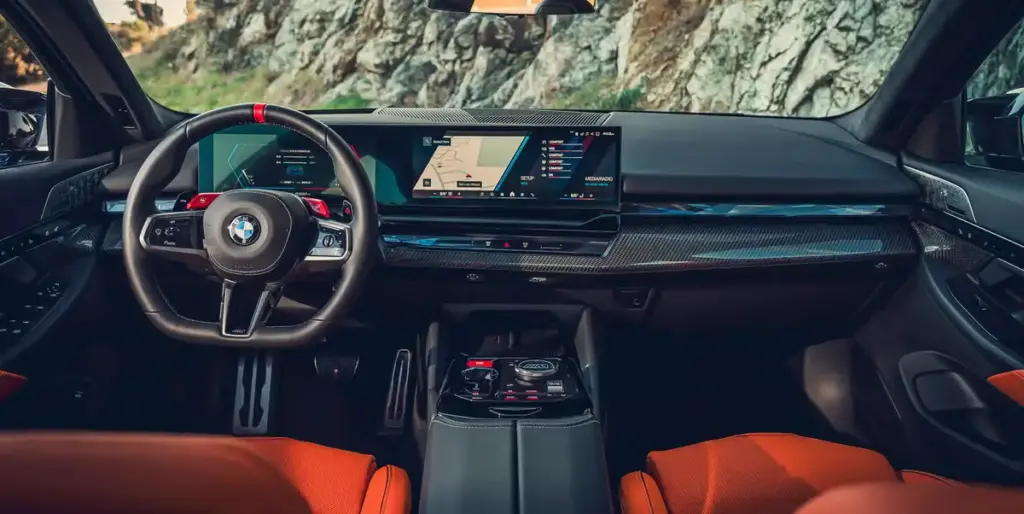
2025 BMW M5 Interior & Cabin Experience
Seating & Space Configuration
The five-passenger layout provides generous space[1]:
- Front legroom: 41.3 inches
- Rear legroom: 36.2 inches
- Seating capacity: Five adults comfortably
- Optional M Carbon bucket seats: Enhanced bolstering for track driving
Standard M sport seats deliver excellent support during spirited driving while maintaining comfort for long-distance touring[1]. Optional M Carbon bucket seats add aggressive bolstering and weight savings but sacrifice some daily driving comfort.
Rear-seat accommodations easily fit adults up to 6’2″ tall, making the M5 genuinely practical for families requiring five-passenger capability[2].
Materials & Build Quality Assessment
Premium materials include[1]:
- Merino leather surfaces on seats, dashboard, and door panels
- Aluminum accents on pedals and interior trim
- Carbon-fiber options for sporty aesthetic
- Piano black trim (fingerprint-prone, criticized by owners)
However, some interior quality concerns emerge at the $120,000+ price point. Owners criticize the extensive piano black plastics that quickly accumulate fingerprints and scratches[5]. Missing luxury features include soft-close doors and comfort access for rear passengers—amenities expected in this segment.
Build quality remains excellent with tight panel gaps and consistent material quality, though some owners report cheaper plastics in high-touch areas compared to competitors[5].
Cargo Capacity & Practicality
Storage varies by body style[1]:
- Sedan trunk: 16.5-17 cubic feet
- Touring cargo: 17.7 cu ft (57.6-58 cu ft with rear seats folded)
Battery placement beneath the rear seats minimally impacts cargo floor height, maintaining practical usability[1]. The Touring wagon provides exceptional versatility for families requiring substantial cargo capacity alongside supercar performance.
Small item storage throughout the cabin includes door pockets, center console compartments, and wireless charging pad placement[1].
Comfort Features & Amenities
Standard comfort equipment includes[1]:
- Heated and ventilated front seats: Three-level temperature control
- Four-zone automatic climate control: Independent rear passenger settings
- Panoramic sunroof: Standard equipment (carbon-fiber roof available)
- Ambient lighting: Customizable colors that sync with drive modes
Optional massage functions add long-distance comfort, while power-adjustable side bolsters and lumbar support ensure optimal driving positions.
Noise Insulation & Refinement
Cabin noise levels vary by drive mode[5]:
- EV mode at 70 mph: 59 dB (exceptionally quiet)
- Hybrid mode at 70 mph: 69 dB
- Sport+ mode: 72+ dB with active exhaust open
Sound insulation improvements over the F90 generation create a serene environment for daily driving, particularly in EV mode[5]. However, the exhaust note disappoints enthusiasts, lacking the aggressive character of previous M5 generations due to emissions regulations[5].
Active noise cancellation further reduces intrusive sounds, though some enthusiasts prefer disabling this system to hear more engine character.
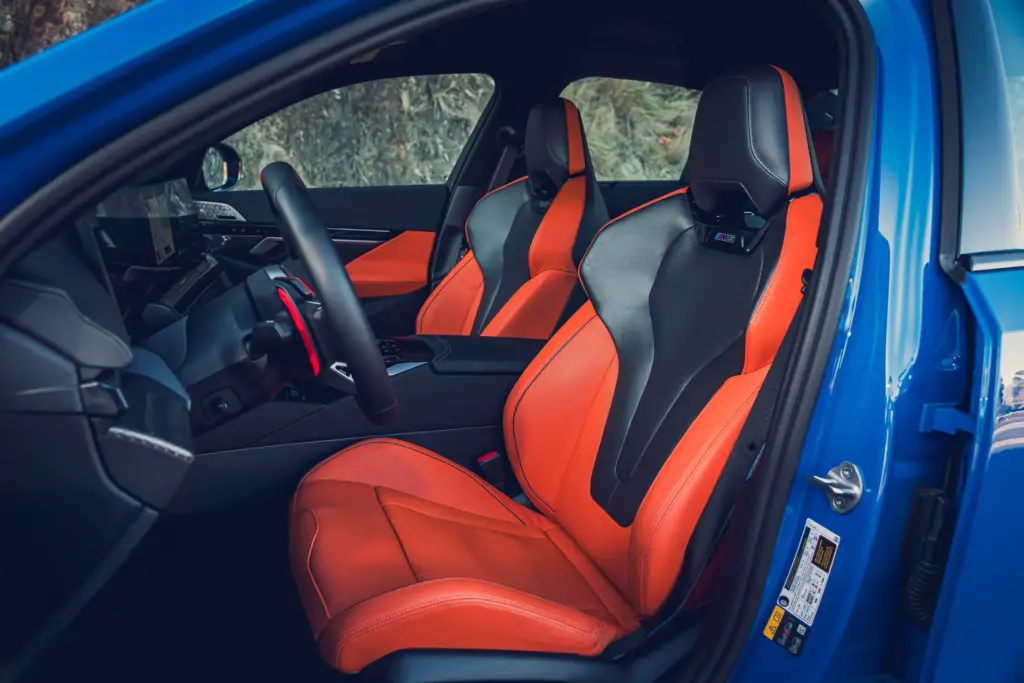
2025 BMW M5 Technology Features
iDrive 8.5 Infotainment System
The latest iDrive iteration features[1]:
- Curved display unit: 12.3-inch digital instrument cluster + 14.9-inch touchscreen
- QuickSelect widgets: Vertical menu bars for frequently-used functions
- Natural language processing: Enhanced BMW Intelligent Personal Assistant
- M-specific graphics: Performance-oriented screen animations and layouts
Menu structure complexity presents a learning curve, though most drivers adapt within several days of ownership[5]. The system’s responsiveness impresses, with minimal lag during touch inputs or voice commands.
The traditional iDrive controller remains available, providing tactile control alternative to touchscreen operation—appreciated by some enthusiasts preferring physical controls while driving[1].
BMW Live Cockpit Professional
Digital instrument cluster customization allows[1]:
- Multiple display themes: Sport, comfort, efficiency-focused layouts
- Performance data displays: G-forces, boost pressure, tire temperatures
- Head-up display: Projects navigation, speed, and performance data onto windshield
- Augmented reality navigation: Overlays directional arrows onto real-world camera view
M-specific gauge cluster animations activate when selecting Sport+ mode, displaying tire temperatures, oil pressure, and boost levels for track-focused drivers[1].
Connectivity & Smartphone Integration
Standard connectivity includes[1]:
- Wireless Apple CarPlay and Android Auto: Seamless smartphone integration
- BMW ConnectedDrive services: Real-time traffic, weather, concierge services
- Wireless charging pad: Convenient device charging without cables
- Remote features: Climate control, charging status monitoring via BMW app
Some owners report occasional wireless CarPlay connection drops requiring manual reconnection—a minor annoyance in otherwise comprehensive technology integration[5].
Driver Assistance Technologies
The optional Driving Assistance Professional Package adds[1]:
- Autonomous emergency braking: Pedestrian and cyclist detection
- Active cruise control: Stop-and-go capability for traffic situations
- Lane-keeping assist: Gentle steering corrections maintain lane position
- Blind-spot monitoring: Visual and audible alerts for adjacent vehicles
- Highway Assistant: Hands-free driving up to 40 mph (limited compared to competitors)
BMW’s driver assistance systems rank among the segment’s best, with smooth lane centering and reliable adaptive cruise functionality[1].
Audio System Options
The standard Bowers & Wilkins surround-sound system delivers[1]:
- 18-speaker configuration: Strategic placement throughout cabin
- Acoustic tuning: Optimized for M5’s cabin characteristics
- Exceptional clarity: Premium audio quality justifying its inclusion as standard equipment
Sound quality rivals systems in luxury vehicles costing significantly more, providing audiophile-grade listening experiences for music enthusiasts.
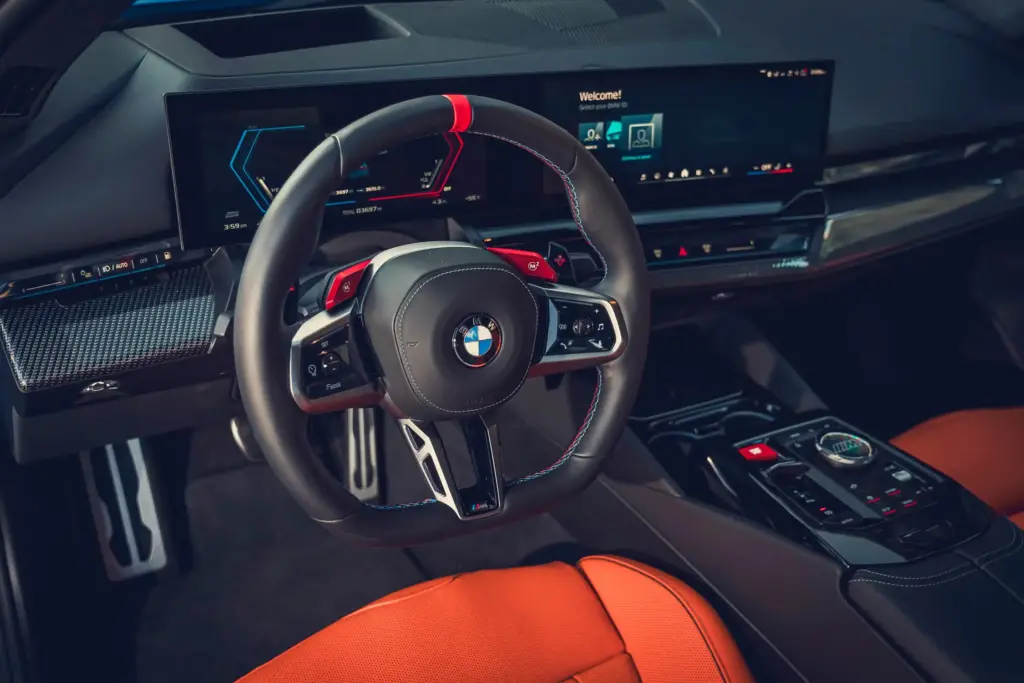
Safety Features & Crash Test Ratings
Active Safety Equipment
Comprehensive standard safety features include[1]:
- Seven airbag system: Front, side, and curtain coverage
- Pedestrian and cyclist detection: Reduces collision severity
- Junction protection: Monitors cross-traffic at intersections
- Speed sign recognition: Displays current speed limits on instrument cluster
These systems work seamlessly together, enhancing safety without hindering the driving experience[1].
ANCAP/NHTSA Safety Ratings
The 5-Series platform received a five-star ANCAP rating, with the M5 sharing the same high-strength steel and aluminum body structure[6]. NHTSA testing results remain pending as of October 2025, though strong performance is expected based on the standard 5-Series’ crash test results.
High-strength steel construction and strategic crumple zones optimize occupant protection during multiple impact angles[1].
Child Safety Features
Family-friendly safety equipment includes[1]:
- ISOFIX/LATCH anchorage points: 2-3 positions in rear seats
- Rear door child locks: Manual override prevents opening from inside
- Window and sunroof safety controls: Prevents pinching hazards
- Rear-seat reminder system: Alerts driver to check back seat before exiting
ISOFIX anchors prove easily accessible, simplifying child seat installation compared to some luxury sedan competitors[1].
Parking & Maneuverability Aids
Optional BMW Parking Assistant Professional includes[1]:
- 360-degree camera: Multiple viewing angles including 3D perspective
- Front and rear parking sensors: Audible and visual distance warnings
- Automated parking assistance: Steers into parallel and perpendicular spaces
These systems help manage the M5’s 77.6-inch width during urban parking situations, where the sedan’s substantial proportions challenge tight spaces[1].

2025 BMW M5 Pricing & Trim Levels
Base MSRP & Starting Price
Current pricing structure shows[1][2]:
- M5 Sedan: $119,500-$123,275 (varies by source)
- M5 Touring: $121,500-$122,675
- Destination charges: ~$1,095 additional
- Average transaction prices: $120,019-$122,019 based on recent sales
Market conditions currently favor buyers, with some dealers offering modest discounts off MSRP, though high-demand markets may still command premiums[1].
Single Trim Strategy Explained
BMW offers the M5 in one comprehensive configuration rather than multiple trim levels[1]. This strategy simplifies ordering while providing extensive standard equipment including:
- Bowers & Wilkins surround sound
- Panoramic sunroof
- Adaptive LED headlights
- Four-zone climate control
- Power-adjustable sport seats
- Wireless smartphone charging
Customization occurs through option packages rather than trim selection, allowing buyers to tailor their M5 to specific preferences without navigating complex trim hierarchies.
Key Option Packages Breakdown
Major packages include[1]:
| Package | Price | Key Features |
|---|---|---|
| Driving Assistance Professional | ~$1,700 | Hands-free highway driving, adaptive cruise |
| M Driver’s Package | $2,500 | 190 mph top speed + performance driving school |
| Executive Package | ~$2,200 | Parking assist, interior camera, ventilated seats |
| M Drive Professional | ~$1,250 | Track telemetry, data logging capabilities |
The M Driver’s Package includes access to BMW’s M Driving School, providing professional instruction on extracting maximum performance from the M5[1].
Major Individual Options
Significant standalone options include[1]:
- Carbon-ceramic brakes: $8,500 (essential for track use, overkill for street driving)
- Extended Merino leather packages: $1,500-$2,000
- Carbon-fiber roof: $2,950 (deletes panoramic sunroof, saves ~25 lbs)
- BMW Individual custom colors: $4,000+ (extensive palette beyond standard offerings)
As-Tested Price Analysis
Fully-loaded examples reach $146,225-$148,000[1]. Most valuable options for typical buyers include:
- Driving Assistance Professional Package: Enhances daily driving convenience
- M Driver’s Package: If planning 190+ mph driving or track school attendance
- Extended Merino leather: Justifies premium pricing with interior ambiance
Options to skip for value-conscious buyers:
- Carbon-ceramic brakes: Unless regular track use planned ($8,500 savings)
- Carbon-fiber roof: Minimal weight savings for substantial cost
- BMW Individual colors: May limit buyer pool during resale
Lease vs purchase considerations favor leasing given the M5’s projected depreciation of 28.8% in year one[7]. Typical lease terms run $1,800-$2,200 monthly with $10,000 down for 36 months.
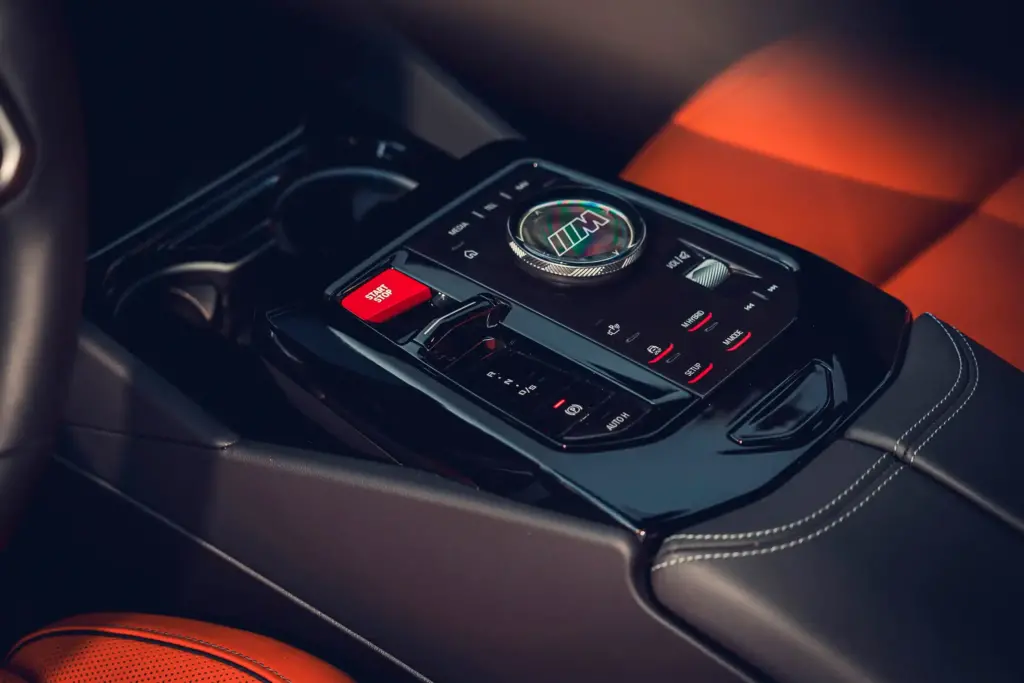
Daily Drivability & Real-World Use
City Driving Experience
Urban driving benefits significantly from EV mode[5]. The 25-27 mile electric range handles typical commutes emissions-free, while stop-and-go traffic becomes tolerable with silent electric propulsion. However, the firm suspension transmits road imperfections even in Comfort mode, making rough urban pavement noticeable[2].
Parking challenges arise from the 200.6-inch length and 77.6-inch width, though the 360-degree camera system aids maneuverability[1]. Visibility remains good despite the low roofline, with minimal blind spots compared to some sports sedans.
Highway Cruising Comfort
The M5 excels as a highway cruiser[1]. The 59-dB cabin noise level in EV mode creates exceptional serenity, while the adaptive suspension absorbs highway expansion joints competently. Active Driving Assistant Pro enables hands-free driving up to 40 mph, reducing driver fatigue during traffic situations.
Fuel efficiency improves to 20-22 mpg at steady 70-mph cruising speeds—substantially better than the EPA’s 17 mpg highway rating[1]. Wind and road noise remain well-controlled, allowing comfortable conversation at highway speeds.
Hybrid System Transition Quality
A significant owner complaint involves EV-to-gas handover lag[5]. Multiple M5 owners report 1-2 second hesitations when transitioning from electric to gas power at low speeds (under 20-30 mph) during aggressive acceleration. The electric motor disengages before the gas engine fully engages, creating noticeable power gaps that frustrate drivers expecting seamless hybrid operation.
Dealer responses vary, with some considering this “normal” behavior while others acknowledge it as a software calibration issue awaiting updates[5]. This problem particularly affects urban driving where frequent transitions occur.
Regenerative braking feel remains smooth, though some drivers require adjustment periods to master the system’s characteristics[2].
Weather Performance Capabilities
The M xDrive system delivers confident all-weather traction[1]. Snow and ice performance benefits from the rear-biased torque distribution, preventing understeer common in front-heavy all-wheel-drive systems. However, the 5.1-inch ground clearance limits deep snow capability compared to SUVs.
Performance summer tires compromise winter traction significantly. Buyers in cold climates should invest in dedicated winter tire packages, as the standard Hankook or Michelin summer tires become dangerously slippery below 40°F.
Stability control interventions remain smooth, maintaining forward progress without jarring interruptions during slippery conditions[1].
Ownership Experience Insights
BMW’s Ultimate Care maintenance program covers scheduled maintenance for 3 years/36,000 miles[1]. This includes oil changes, brake fluid, and inspection services—valuable given typical $1,200-$1,500 annual maintenance costs after the complimentary period expires.
Digital key functionality works reliably on most smartphones, enabling keyless entry and starting via phone[5]. The BMW Connected app allows remote climate control and charging status monitoring, enhancing convenience for daily use.
BMW M community events provide networking opportunities with fellow M5 owners, including track days and social gatherings organized by regional BMW Car Clubs[1].
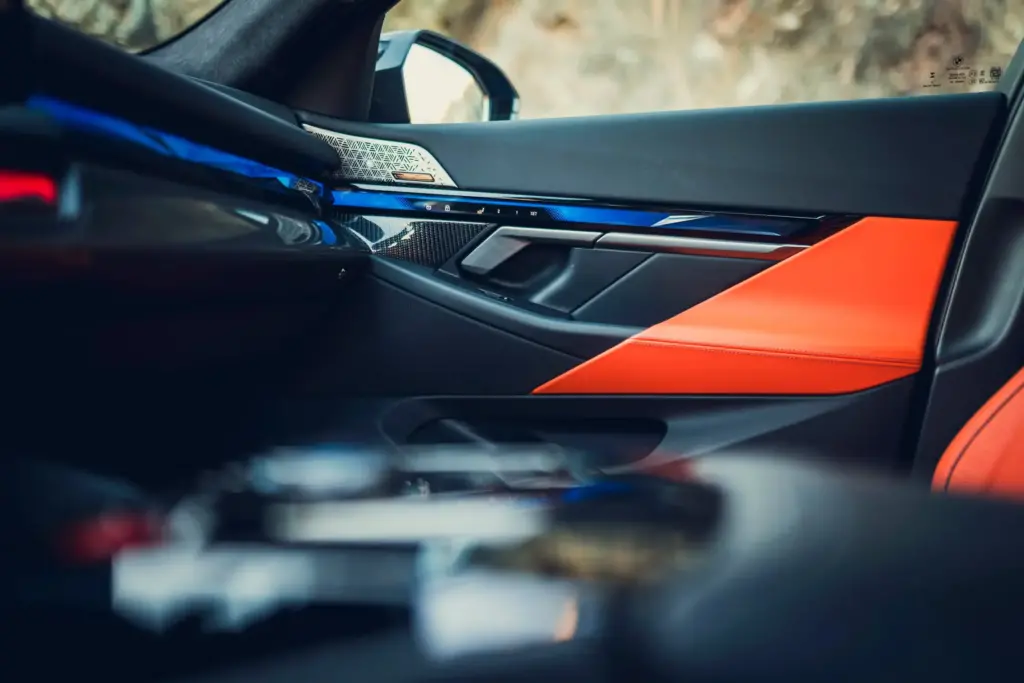
Track Performance & Enthusiast Driving
Circuit Driving Capability
The M5 demonstrates impressive track competence despite its 5,251-pound weight[1]. Lap times approach competitors like the Audi RS7 Performance on most circuits, with the carbon-ceramic brakes resisting fade during repeated hard stops. The active differential optimizes corner-exit traction, allowing aggressive throttle application without sacrificing stability.
Tire temperature management remains critical during extended sessions. The performance-oriented Hankook or Michelin tires handle moderate track use adequately, though dedicated track days benefit from Michelin Pilot Sport Cup 2R tires[1].
Cooling system performance proves adequate under sustained loads, though oil and brake fluid temperatures require monitoring during aggressive track use[2].
M-Specific Performance Features
Track-focused features include[1]:
- M Sport differential: Active limited-slip with variable locking percentages
- Configurable M buttons: Save preferred driving mode combinations on steering wheel
- Traction control levels: 10 adjustable intervention settings from full assistance to off
- Data logging: Performance telemetry recording for post-session analysis
These features allow experienced drivers to tailor the M5’s behavior to specific track characteristics and personal driving styles[1].
Drift Mode & RWD Behavior
Activating drift mode requires disabling stability control and selecting 2WD mode[5]. However, owners report the hybrid system and traction controls interfere with traditional burnouts and drifts compared to the more playful F90 generation. The electric motor’s instant torque delivery complicates drift initiation, requiring different techniques than pure-combustion M5 models.
The rear-bias power delivery feels authentic once drifts initiate, though the substantial weight requires more effort to maintain controlled slides[5]. Enthusiasts seeking maximum tail-happiness may find the F90 M5 Competition more rewarding.
Weight Impact on Driving Feel
The 5,251-pound curb weight fundamentally affects steering feedback and chassis communication[3]. The steering feels overly light and lacks the connection drivers expect from M5 models, with minimal road feedback transmitted through the electrically-assisted system.
Momentum management through corners requires anticipation and earlier braking compared to lighter competitors[3]. The adaptive suspension compensates admirably, but physics ultimately limits how well technology can disguise mass.
Comparison to lighter competitors like the 4,600-pound Audi RS7 Performance or 4,123-pound Cadillac CT5-V Blackwing reveals the M5’s weight disadvantage during aggressive cornering[8].
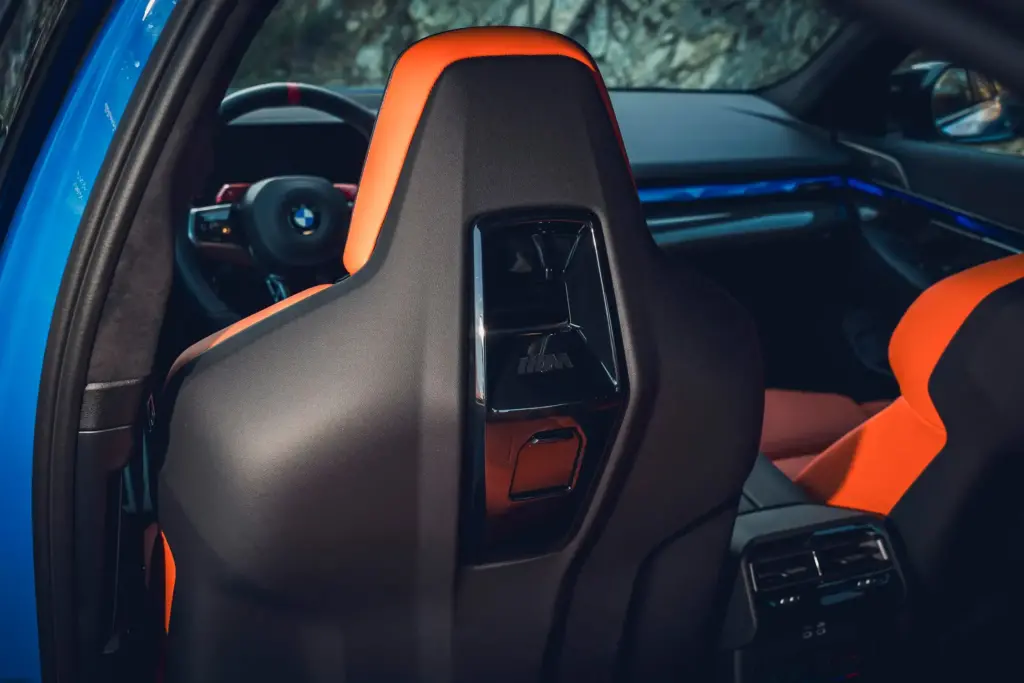
2025 BMW M5 Competitive Comparison
vs. Audi RS7 Performance ($131,195)
| Specification | BMW M5 | Audi RS7 Performance |
|---|---|---|
| Power | 717 hp | 621 hp |
| Weight | 5,251 lbs | ~4,600 lbs |
| 0-60 mph | 3.0-3.4 sec | ~3.5 sec |
| Electric Range | 25-27 miles | N/A |
| Starting Price | $119,500 | $131,195 |
The M5 outperforms the RS7 in straight-line acceleration but trails in handling agility due to the 650-pound weight disadvantage[8]. The RS7 offers more distinctive hatchback styling and a more engaging exhaust note, while the M5’s hybrid system provides genuine electric-only driving capability—significant for urban commuters.
vs. Mercedes-AMG E63 S
The AMG E63 S delivers 603 hp from a traditional twin-turbo V8, weighing approximately 4,700 lbs[8]. This 550-pound weight advantage translates to sharper handling and more responsive steering feel. The M5 edges out the Mercedes in acceleration tests, but the E63 S offers a more visceral, raw driving character that purists prefer.
The E63 S lacks the M5’s electric range capability, making it less practical for buyers prioritizing efficiency alongside performance. Interior quality remains comparable between both vehicles, though Mercedes’ MBUX infotainment system offers different interface philosophy than BMW’s iDrive[8].
vs. Cadillac CT5-V Blackwing
The supercharged V8-powered CT5-V Blackwing offers manual transmission availability and significantly lighter curb weight (4,123 lbs)[8]. At approximately $90,000, the Cadillac costs $30,000-$35,000 less than the M5 while delivering superior steering feel and driving engagement.
However, the Blackwing lacks the M5’s hybrid technology, all-wheel drive, and luxury appointment levels. For driving purists prioritizing engagement over technology, the Blackwing represents exceptional value. But buyers seeking cutting-edge hybrid performance and electric range find the M5 more appealing[8].
vs. Porsche Panamera Turbo S E-Hybrid
The Panamera Turbo S E-Hybrid shares the M5’s plug-in hybrid philosophy with refined chassis tuning and superior ride quality[8]. Porsche’s active engine mounts and sway bars deliver exceptional daily comfort while maintaining performance capability. Interior quality exceeds the M5’s fit and finish, justifying its higher price premium.
However, the M5 offers more rear passenger space and cargo capacity, making it more practical for families. The Panamera targets buyers prioritizing ultimate luxury and chassis sophistication over maximum practicality[8].
vs. BMW i5 M60 (Electric Alternative)
Direct comparison to BMW’s electric i5 M60 reveals interesting contrasts[3]:
| Metric | M5 | i5 M60 |
|---|---|---|
| Power | 717 hp | 593 hp |
| 0-60 mph | 3.0-3.4 sec | 3.5 sec |
| Weight | 5,251 lbs | 5,233 lbs |
| Lateral Grip | 1.02 g | 0.95 g |
| Braking (60-0) | 118 ft* | 104 ft |
| Starting Price | $119,500 | $85,095 |
The M5 outperforms the i5 in acceleration and lateral grip, though the electric sedan delivers superior braking performance[3]. The i5’s 264-mile range eliminates range anxiety compared to the M5’s 25-27 mile electric capability. However, the M5’s V8 provides unlimited range via gasoline, eliminating charging infrastructure concerns.
The $34,405 price difference favors the i5 for buyers comfortable with full-electric operation. Those requiring long-distance flexibility or V8 soundtrack justify the M5’s premium[3].
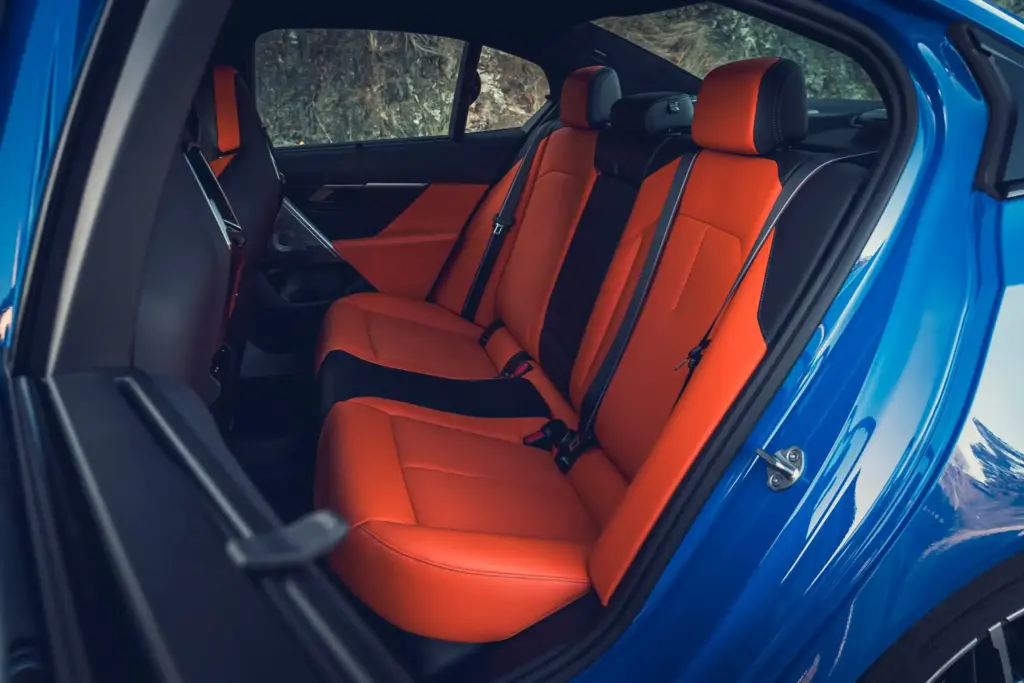
Common Problems & Owner Concerns
Hybrid Handover Lag Issues
The most common complaint involves EV-to-gas transition delays[5]. Multiple owners report 1-2 second hesitations during low-speed acceleration (under 20-30 mph) when transitioning from electric to gas power. The electric motor disengages before the V8 fully engages, creating noticeable power gaps that frustrate drivers expecting seamless operation.
Dealer awareness varies significantly. Some service advisors acknowledge this as a software calibration issue requiring updates, while others dismiss it as “normal” hybrid behavior[5]. BMW has not issued official statements regarding timing for corrective software updates.
Charging System Limitations
The base 7.4 kW charger proves slow for daily use, requiring nearly 3 hours for full battery replenishment[1]. The Touring’s upgraded 11 kW charger reduces this to approximately 1.5-2 hours, but BMW should offer the faster charger on sedans as well.
Public charging infrastructure compatibility remains limited compared to dedicated EVs. Most Level 2 chargers support the M5’s needs, but charging away from home requires advance planning to locate compatible stations.
Home charging installation requires 240V electrical service, adding $1,000-$2,500 to ownership costs depending on existing infrastructure[1].
Interior Quality Criticisms
Multiple owners criticize interior aspects at the $120,000+ price point[5]:
- Piano black trim: Shows fingerprints and scratches easily, appearing cheap
- Plastic quality: Some high-touch areas use cheaper plastics than expected
- No soft-close doors: Expected luxury feature missing
- No rear comfort access: Rear doors require manual unlocking
Comparison to luxury sedan standards from Mercedes-Benz and Porsche reveals the M5 falling slightly short in material richness and feature completeness[5].
Steering Feel & Feedback
The overly light, numb steering character ranks among the most common enthusiast complaints[3]. The electric power steering system lacks connection and road feedback compared to the F90 M5, with minimal communication about surface conditions or tire grip levels. The steering feels lighter than expected for a 5,251-pound vehicle, creating disconnection during spirited driving.
Comparison to competitor steering systems shows the Cadillac CT5-V Blackwing delivering significantly better feedback, while even the Mercedes-AMG E63 S provides more steering communication[8].
Infotainment Complexity
iDrive 8.5 presents a learning curve for new BMW owners[5]. The app-screen menu navigation while driving requires attention diversion, with touchscreen reliance increasing as the traditional iDrive controller becomes less intuitive for newer system iterations. Most owners adapt within a week, though some longtime BMW enthusiasts prefer the simpler iDrive 7 interface from previous models.
Over-reliance on touchscreen controls frustrates drivers who prefer physical buttons for climate and audio adjustments while driving[5].
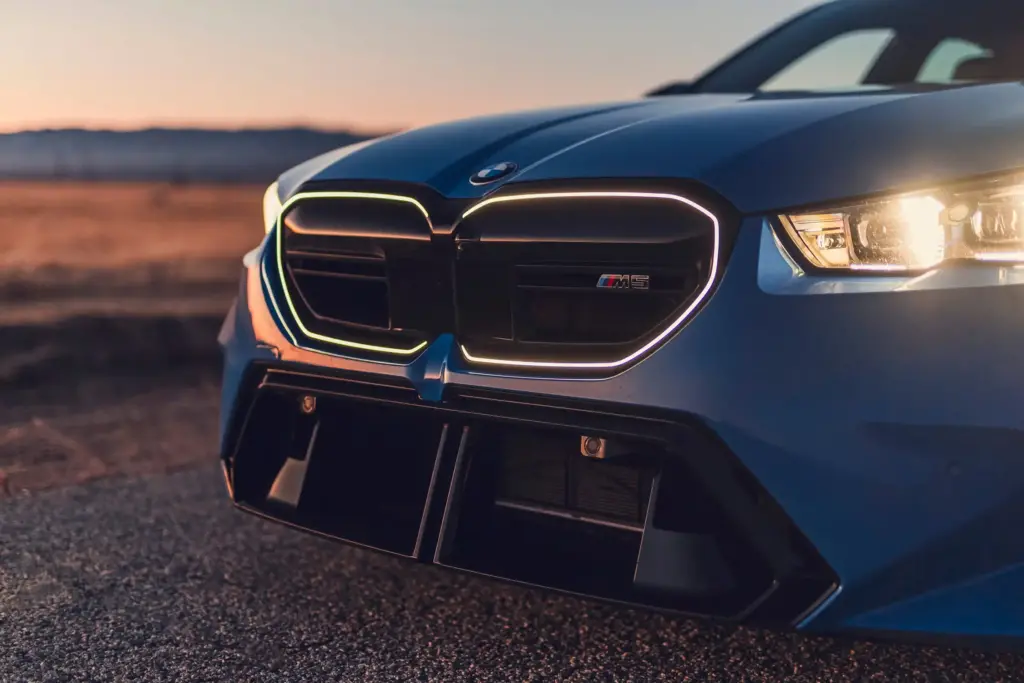
2025 BMW M5 Used Market & Resale Value
Depreciation Projections
Historical M5 depreciation data projects significant value loss[7]:
| Timeframe | Depreciation % | Value Loss | Projected Value |
|---|---|---|---|
| Year 1 | 28.8% | $35,174 | $87,101 |
| Year 3 | 35.1% | $42,900 | $79,279 |
| Year 5 | 43% | $52,500 | $69,896 |
| Year 10 | 72% | $87,900 | $34,148 |
The M5 loses approximately 60% of its value after five years, ranking in the 25th-75th percentile for sedan depreciation[7]. First-year depreciation averages around $35,000, making immediate new purchase timing financially disadvantageous compared to waiting for used inventory.
Current Used Market Availability
As of October 2025, minimal used 2025 M5 inventory exists given the model’s recent introduction[7]. Early adopter trade-ins remain rare, though some buyers dissatisfied with the hybrid system or weight characteristics have listed vehicles with under 5,000 miles.
Certified Pre-Owned (CPO) availability timeline suggests significant inventory won’t appear until Q2 2026, as lease returns and trade-ins accumulate. BMW’s CPO program offers extended warranty coverage (up to 6 years/100,000 miles total) and competitive financing rates.
Market demand remains strong for well-optioned examples, particularly M5 Touring wagons which command premiums due to limited production allocations[1].
Factors Affecting M5 Resale Value
Several factors influence depreciation rates[7]:
- Hybrid system complexity: Future buyers may worry about battery degradation and replacement costs ($8,000-$15,000 estimated)
- Mileage impact: High-mileage examples (20,000+ annual miles) depreciate faster than garage-kept weekend cars
- Color desirability: Neutral colors (Black, White, Grey) maintain stronger resale than bold Individual colors
- Option packages: Driving Assistance Professional and M Driver’s Package enhance resale appeal
Battery degradation concerns remain speculative, as the M5’s lithium-ion pack includes thermal management and warranty coverage, but long-term reliability data won’t emerge for several years.
Best Time to Buy Used
Optimal used purchase timing occurs during[7]:
- Q4 model-year transitions: Dealerships clear previous-year inventory
- Post-lease return periods: 36-month leases from 2025 deliveries create Q1 2028 inventory surge
- Winter months: Reduced performance car demand lowers prices in cold-weather states
CPO versus private party purchasing shows CPO examples commanding $3,000-$5,000 premiums but providing warranty coverage and inspection certainty. Private party purchases offer lower prices but require thorough pre-purchase inspections to verify maintenance history and detect potential issues.
Financing rate differences show CPO programs offering competitive rates (currently 4.49%-5.99% APR) versus private party purchases requiring traditional auto loans at higher rates.
Alternative Used Options to Consider
Buyers seeking M5 performance at lower prices should explore[7]:
- 2018-2024 F90 M5 Competition: $70,000-$90,000 range, 617 hp, significantly lighter weight (4,345 lbs)
- 2021-2023 F90 M5 CS: $115,000-$140,000, limited edition with 4,174 lbs curb weight
- 2018-2020 F90 M5: $58,000-$70,000, first-generation G30 platform
- E60 M5 V10 (2006-2010): $35,000-$55,000, collector appeal but high maintenance costs
Alternative brand super sedans include used Audi RS7 ($65,000-$80,000) and Mercedes-AMG E63 S ($60,000-$75,000) offering different philosophies at substantial savings versus new pricing.
For additional perspective on used car purchasing criteria, understanding how many miles is good for a used car helps evaluate mileage thresholds for luxury performance vehicles.
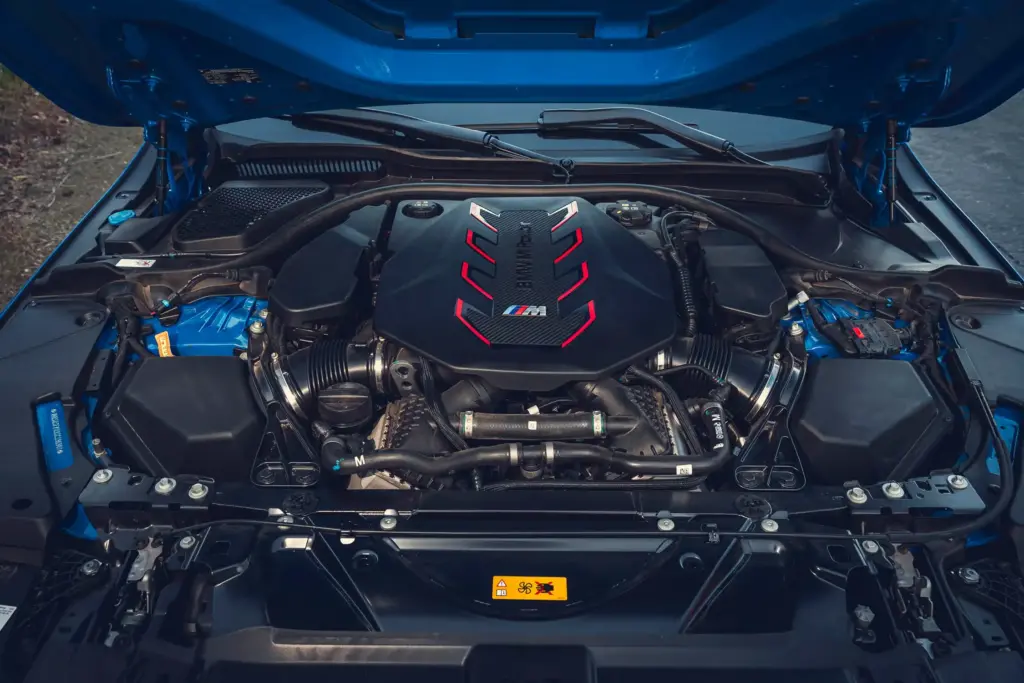
Final Verdict: Should You Buy the 2025 BMW M5?
Who Should Buy This M5
The 2025 M5 excels for specific buyer profiles[1][2]:
- Tech-forward executives seeking latest automotive innovations with genuine electric commuting capability
- Luxury performance buyers prioritizing comfort and refinement over raw driving engagement
- Families requiring practical five-passenger super sedan space, especially Touring wagon buyers
- Daily drivers with occasional track aspirations rather than dedicated weekend performance enthusiasts
According to Autvex analysis, the M5’s hybrid system delivers genuine real-world benefits for urban commuters, with 30-40 miles of electric range eliminating gasoline usage for daily driving. The combination of 717 horsepower and emissions-free operation creates unique positioning in the super sedan segment.
Who Should Look Elsewhere
Consider alternatives if priorities include[3][8]:
- Driving purists seeking analog engagement and visceral feedback should explore the Cadillac CT5-V Blackwing
- Weight-conscious enthusiasts prioritizing agility over straight-line speed benefit from lighter competitors
- Budget-focused buyers find the $90,000 CT5-V Blackwing offers 80% of performance at 65% of cost
- Manual transmission enthusiasts require the Blackwing’s three-pedal option (no manual M5 available)
Previous-generation F90 M5 Competition models provide more engaging driving experiences at $70,000-$90,000 used pricing, sacrificing hybrid technology and latest iDrive system for superior handling dynamics.
Best Configuration Recommendations
Optimal configuration strategy[1]:
Body Style Selection:
- Sedan: Most buyers seeking traditional proportions and lower pricing
- Touring: Families requiring maximum cargo versatility (57.6 cu ft seats folded)
Must-Have Options:
- Driving Assistance Professional Package ($1,700): Enhances daily driving convenience
- M Driver’s Package ($2,500): If planning track school attendance or 190 mph capability
- Extended Merino leather ($1,500): Elevates interior ambiance to match pricing
Skip-Worthy Options:
- Carbon-ceramic brakes ($8,500): Unless regular track use planned
- Carbon-fiber roof ($2,950): Minimal weight savings for substantial cost
- BMW Individual colors ($4,000+): May limit buyer pool during resale
Ideal Color Combinations:
- Storm Bay or Brooklyn Grey with Black Extended Merino: Strong resale appeal
- Isle of Man Green with Kyalami Orange interior: Bold statement for enthusiasts
- Frozen Deep Grey with Dark Violet interior: Contemporary luxury aesthetic
Recommended total configuration: $128,000-$135,000 including valuable options while avoiding overpriced accessories.
Lease vs Buy Analysis
Financial analysis favors leasing given steep first-year depreciation[7]:
Lease Advantages:
- Typical terms: $1,800-$2,200/month with $10,000 down (36 months)
- Avoid $35,000+ first-year depreciation hit
- Always drive latest technology with 3-year lease cycles
- Lower monthly payments versus purchase financing
Purchase Advantages:
- No mileage restrictions (leases limit 10,000-15,000 annual miles)
- Modification freedom for personalization
- Potential long-term value if maintaining beyond 5+ years
- No wear-and-tear penalties at lease end
Current BMW Financial Services rates show purchase financing from 2.9%-5.9% APR for qualified buyers, with lease money factors translating to similar effective rates[1].
Ownership costs beyond purchase price include:
- Insurance: $3,500-$5,000 annually (high-performance classification)
- Maintenance: Complimentary for 3 years, then $1,200-$2,000 annually
- Fuel costs: $3,500-$5,000 annually (15,000 miles/year, mixed driving)
- Tire replacement: $1,600-$2,000 per set every 15,000-25,000 miles
The Bottom Line
The 2025 BMW M5 succeeds as a technological showcase that reimagines the super sedan formula for an electrified future[1][2]. Its 717-hp plug-in hybrid powertrain delivers mind-bending acceleration (0-60 mph in 3.0 seconds) while providing 25-27 miles of genuine electric-only capability—transformative for urban commuters.
However, the 1,045-pound weight penalty fundamentally alters the M5’s character from previous generations[3]. The steering lacks connection, the chassis can’t fully disguise 5,251 pounds through corners, and the hybrid transition quality frustrates owners expecting seamless operation. These compromises sacrifice some driving purity that defined earlier M5 models.
At $119,500-$146,225, the M5 represents strong value against the $131,195 Audi RS7 Performance, offering more power, electric range, and comparable luxury[1][8]. For buyers prioritizing technology, refinement, and versatility over pure driving engagement, the 2025 M5 delivers compelling performance and practicality.
- Autvex Rating: 8.3/10 – Highly recommended for tech-forward luxury performance buyers; enthusiasts seeking lightweight dynamics should test-drive thoroughly before committing.
The M5’s hybrid gamble pays dividends for daily usability while maintaining supercar-level acceleration, though driving purists may lament the loss of analog character that made previous M5 generations legendary.

Key Takeaways
- First plug-in hybrid M5 delivers 717 hp with 25-27 miles electric range, genuinely useful for emissions-free urban commuting.
- 3.0-second 0-60 mph acceleration matches supercars costing significantly more, with 738 lb-ft torque providing explosive thrust.
- 1,045-pound weight gain compromises handling precision, requiring adaptive suspension and four-wheel steering to mask mass through corners.
- Hybrid transition lag frustrates owners with 1-2 second hesitations during EV-to-gas handovers at low speeds awaiting software fixes.
- Strong value versus $131,195 Audi RS7 with more power and electric capability at $119,500 starting price.
- Steep 28.8% first-year depreciation makes leasing financially prudent versus purchasing for typical 3-year ownership horizons.
- M5 Touring wagon offers exceptional practicality with 57.6 cubic feet cargo space while maintaining 717 hp performance credentials.
FAQs
Is the 2025 BMW M5 a plug-in hybrid?
Yes, the 2025 M5 is BMW’s first-ever plug-in hybrid M5, combining a twin-turbo 4.4L V8 (577 hp) with an electric motor (194 hp) for 717 hp combined output[1]. It offers 25-27 miles of EPA-estimated electric-only range on a 14.8-kWh battery.
How much horsepower does the 2025 BMW M5 have?
The 2025 M5 produces 717 horsepower and 738 lb-ft of torque combined from its hybrid powertrain[1]. The V8 alone generates 577 hp, while the electric motor adds 194 hp. This represents a 100 hp increase over the previous F90 M5’s 617 hp.
What is the 0-60 mph time for the 2025 BMW M5?
The 2025 M5 accelerates from 0-60 mph in 3.0-3.4 seconds depending on testing conditions and methodology[1]. Car and Driver achieved 3.0 seconds flat, while other publications recorded 3.2-3.4 seconds. Quarter-mile times range from 10.9-11.2 seconds.
How much does the 2025 BMW M5 weigh?
What is the electric range of the 2025 BMW M5?
The EPA rates the M5 at 25-27 miles of all-electric range[1]. Real-world testing shows city driving can achieve 30-40 miles, significantly exceeding EPA estimates. Pure electric operation functions up to 87 mph before the V8 automatically engages.
Is the 2025 BMW M5 all-wheel drive?
Yes, all 2025 M5 models feature BMW’s M xDrive all-wheel-drive system with rear-biased torque distribution[1]. The system includes a drift mode enabling 100% rear-wheel-drive operation for enthusiast driving. No rear-wheel-drive-only variant is offered.
How much does the 2025 BMW M5 cost?
The 2025 M5 sedan starts at $119,500-$123,275 depending on source, while the M5 Touring begins at $121,500-$122,675[1]. Fully-loaded examples reach $146,225-$148,000 with all option packages. Average transaction prices run $120,019-$122,019 based on recent sales.
Is there a wagon version of the 2025 BMW M5?
Yes, the 2025 M5 Touring marks the first-ever M5 wagon officially offered in the United States[2]. It provides 17.7 cubic feet of cargo space (57.6 cubic feet with rear seats folded) while maintaining identical 717 hp performance specifications as the sedan.
What is the fuel economy of the 2025 BMW M5?
The EPA rates the M5 at 14 mpg combined on gasoline alone (12 city/17 highway) or 50 MPGe combined with gas and electricity[1]. Real-world testing by Car and Driver observed 18 mpg in mixed driving, with highway cruising achieving 20-22 mpg.
How does the 2025 BMW M5 compare to the Audi RS7?
Is the 2025 BMW M5 faster than the previous generation?
Yes, the 2025 M5’s 0-60 mph time of 3.0-3.4 seconds beats the F90 M5 Competition’s 3.1-3.3 seconds[1]. The hybrid system’s 717 hp (versus 617 hp) and instant electric torque create quicker acceleration, though the 1,045-pound weight gain compromises handling agility.
Does the 2025 BMW M5 have good steering feel?
Can the 2025 BMW M5 drift in RWD mode?
Yes, but with difficulty compared to previous M5 models[5]. Drift mode requires disabling stability control and selecting 2WD operation. However, the hybrid system and traction controls interfere with traditional burnouts, making the F90 M5 more playful for enthusiast driving.
What are common problems with the 2025 BMW M5?
The most common issue involves hybrid transition lag with 1-2 second hesitations during EV-to-gas handovers at low speeds[5]. Other concerns include numb steering feel, piano black trim fingerprints, 7.4 kW slow charging (sedan), and missing luxury features like soft-close doors at the $120,000+ price point.
Is the 2025 BMW M5 worth buying over competitors?
Yes, for tech-forward buyers prioritizing electric range and latest technology[1][8]. The M5’s 717 hp, 25-mile electric range, and $119,500 starting price offer strong value versus the $131,195 Audi RS7. However, driving purists seeking engagement should consider the $90,000 Cadillac CT5-V Blackwing instead.
References
- Car and Driver. (2025). 2025 BMW M5 Review, Pricing, and Specs. https://www.caranddriver.com/bmw/m5
- MotorWeek. (2025). 2025 BMW M5 Road Test: Plugging Into A Whole New World. https://motorweek.org/road-tests/2025-bmw-m5/
- Edmunds. (2025). 2025 BMW M5 vs. BMW i5 M60: Which 5 Series Is Truly M-Worthy? https://www.edmunds.com/car-news/2025-bmw-m5-i5-m60-comparison-test-feature.html
- BMW USA. (2025). 2025 BMW X5 M Competition Specifications. https://www.bmwusa.com/
- BMW Blog. (2025). The Top 5 Things I Love—and Don’t Love—About the New BMW M5. https://www.bmwblog.com/
- ANCAP. (2024). BMW 5 Series Safety Rating. https://www.ancap.com.au/
- CarEdge. (2024). BMW M5 Depreciation. https://caredge.com/bmw/m5/depreciation
- Car and Driver. (2025). Audi RS7 vs. BMW M5 vs. Cadillac CT5-V Blackwing Comparison Test. https://www.caranddriver.com/reviews/comparison-test/

I am a senior automotive analyst at Autvex. Expert vehicle evaluations, in-depth reviews, and objective analysis helping readers make informed automotive decisions with years of industry experience.

